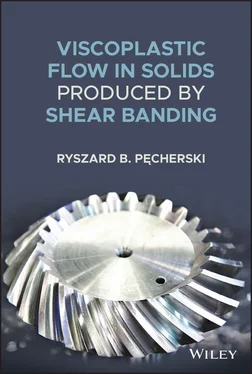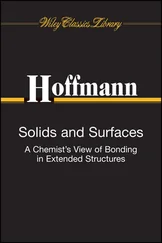A new physical model of multilevel hierarchy and evolution of micro‐shear bands is at the centre of this work. An original idea of extending the representative volume element (RVE) concept using the general theory of propagation of the singular surfaces of microscopic velocity field sweeping the RVE appears useful for the macroscopic description of shear‐banding mechanism in viscoplastic flow, cf. Pęcherski (1997, 1998). The essential novelty of the presented approach comes from numerous observations revealing that the process of shear banding is the driving factor – a cause and not a result.So it turns out, in my view, that the successive generations of micro‐shearing processes induced mostly by changing deformation path produces and controls viscoplastic flow. On the other hand, one may recall many valuable papers containing the results of in‐depth analysis, modelling of dislocation‐mediated multi‐slip plastic deformation, and numerical simulations of the laminate microstructure, bands, or shear strain localisation in crystalline solids cf. Dequiedt (2018), Anand and Kothari (1996), Havner (1992), as well as Petryk and Kursa (2013) and the wealth of papers cited herein.
Recent studies reveal that two types of shear banding, generating the inelastic deformation in materials, can play a pivotal role.
The first type corresponds to the rapid formation of the multiscale shear‐banding systems. It contains micro‐shear bands of the thickness of the order of the 0.1 μm, which form clusters. The clusters propagate and produce the discontinuity of microscopic velocity field vm. They spread over the RVE of a traditional polycrystalline metallic solid. A detailed discussion of such a case is presented in Pęcherski (1997, 1998). A new concept of the RVE with a strong singularity appears, and the instantaneous shear‐banding contribution function fSB originates.
The second type is a gradual, cumulative shear banding that collects micro‐shear bands' particular contributions and clusters. Finally, they accumulate in the localisation zone spreading across the macroscopic volume of considered material. Such a deformation mechanism appears in amorphous solids as glassy metals or polymers. It seems that there are the local shear transformation zones (s) behind the cumulative kind of shear banding, cf. Argon (1979, 1999), Scudino et al. (2011), and Greer et al. (2013). The volumetric contribution function of shear banding appears in such a case.
Often both types of the above‐mentioned shearing phenomena appear with variable contribution during the deformation processes. During shaping operations, this situation can arise in polycrystalline metallic solids, typically accompanied by a distinct change of deformation or loading paths or a loading scheme. Also, materials revealing the composed, hybrid structure characterizing with amorphous, ultra‐fine grained (), and nanostructural phases are prone to the mixed type of shear banding responsible for inelastic deformation, cf. the recent results of Orava et al. (2021) and Ziabicki et al. (2016).
The commonly used averaging procedures over the RVE need deeper analysis to account for the multilevel shear‐banding phenomena. The RVE of crystalline material is the configuration of a body element idealized as a particle. The particle becomes a carrier of the inter‐scale shearing effect producing the viscoplastic flow. It leads to an original and novel concept of the particle endowed with the transfer of information on a multilevel hierarchy of micro‐shear bands developing in the body element of crystalline material. The discussion about the difficulties and shortcomings of applying a traditional direct multiscale integration scheme appears in Chapter 4. The remarks mentioned above motivate the core subject of the work and underline the new way of thinking.
Ryszard B. Pęcherski
2022
Kraków and Warszawa, Poland
I want to express my gratitude for the helpful and friendly guidance offered during my writing efforts shown by Wiley’s competent and patient staff led by Ms Juliet Booker, Managing Editor. Thank you very much for accompanying me on my long journey to navigate the bumpy roads of British syntax and phraseology. In such a case, the role of my cicerone – Ms Nandhini Tamilvanan, Content Refinement Specialist – appeared invaluable. Last but not least, acknowledgement belongs to the Creative Services Team coordinated by Ms Becky Cowan, Editorial Assistant, in preparing the book’s cover. Their professionalism led me to choose the motif that sheds new light in Chapter 1 on the relevant issues related to industrial applications.
1 Anand, L. and Kothari, M. (1996). A computational procedure for rate‐independent crystal plasticity. J. Mech. Phys. Solids. 44: 525–558.
2 Argon, A.S. (1979). Plastic deformation in metallic glasses. Acta Metall. 27: 47–58.
3 Argon, A.S. (1999). Rate processes in plastic deformation of crystalline and noncrystalline solids. In: Mechanics and Materials: Fundamentals and (ed. M.A. Linkages, R.W.A. Meyers and H. Kirchner), 175–230. New York: Wiley.
4 Bai, Y. and Wierzbicki, T. (2008). A new model of metal plasticity and fracture with pressure and Lode dependence. Int. J. Plast. 24: 1071–1096.
5 Dequiedt, J.L. (2018). The incidence of slip system interactions on the deformation of FCC single crystals: system selection and segregation for local and non‐local constitutive behavior. Int. J. Solids Struct. 141–142: 1–14.
6 Dunand, M. and Mohr, D. (2010). Hybrid experimental–numerical analysis of basic ductile fracture experiments for sheet metals. Int. J. Solids Struct. 47: 1130–1143.
7 Dunand, M. and Mohr, D. (2011). On the predictive capabilities of the shear modified Gurson and the modified Mohr–Coulomb fracture models over a wide range of stress triaxialities and Lode angles. J. Mech. Phys. Solids. 59: 1374–1394.
8 Gorij, M.B. and Mohr, D. (2017). Micro‐tension and micro‐shear experiments to characterize stress‐state dependent ductile fracture. Acta Mater. 131: 65–76.
9 Greer, A.L., Cheng, Y.Q., and Ma, E. (2013). Shear bands in metallic glasses. Mater. Sci. Eng., R.74: 71–132.
10 Gurson, A.L. (1977). Continuum theory of ductile rupture by void nucleation and growth. I. Yield criteria and flow rules for porous ductile media. J. Eng. Mater. Technol. 99: 2–15.
11 Havner, K.S. (1992). Finite Plastic Deformation of Crystalline Solids. Cambridge University Press.
12 Nielsen, K.L. and Tvergaard, V. (2010). Ductile shear failure of plug failure of spot welds modeled by modified Gurson model. Eng. Fract. Mech. 77: 1031–1047.
13 Orava, J., Balachandran, S., Han, X. et al. (2021). In situ correlation between metastable phase‐transformation mechanism and kinetics in a metallic glass. Nat. Commun. 12: 2839. https://doi.org/10.1038/s41467=021‐23028‐9.
14 Pardoen, T. (2006). Numerical simulation of low stress triaxiality of ductile fracture. Comput. Struct. 84: 1641–1650.
15 Pęcherski, R.B. (1997). Macroscopic measure of the rate of deformation produced by micro‐shear banding. Arch. Mech. 49: 385–401.
16 Pęcherski, R.B. (1998). Macroscopic effects of micro‐shear banding in plasticity of metals. Acta Mech. 131: 203–224.
17 Petryk, H. and Kursa, M. (2013). The energy criterion for deformation banding in ductile single crystals. J. Mech. Phys. Solids. 61: 1854–1875.
18 Scudino, S., Jerliu, B., Pauly, S. et al. (2011). Ductile bulk metallic glasses produced through designed heterogeneities. Scr. Mater. 65: 815–818.
19 Shima, S. and Oyane, M. (1976). Plasticity for porous solids. Int. J. Mech. Sci. 18: 285–291.
20 Shima, S., Oyane, M., and Kono, Y. (1973). Theory of plasticity for porous metals. Bull. JSME. 16: 1254–1262.
Читать дальше












